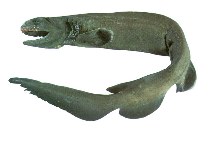| Family: |
Chlamydoselachidae (Frilled sharks) |
| Max. size: |
200 cm TL (male/unsexed) |
| Environment: |
bathydemersal; marine; depth range 0 - 1570 m |
| Distribution: |
Wide-ranging but with patchy distribution. Western Indian Ocean: off South Africa. Western Pacific: off Japan to New Zealand. Eastern Pacific: southern California, USA to northern Chile. Eastern Atlantic: northern Norway to northern Namibia, possibly the eastern Cape of Good Hope, South Africa. Three specimens have been recorded from the western Atlantic (Ref. 13608). |
| Diagnosis: |
Dorsal spines (total): 0-0; Dorsal soft rays (total): 0-0; Anal spines: 0-0; Anal soft rays: 0-0; Vertebrae: 146-171. Eel-like shark with 6 gill slits, the lower ends of the first gill slits connected t each other across throat (Ref. 247). Dark brown or grey in color, sometimes paler below (Ref. 26346). Dorsal fin small and lobe-like originating over pelvic fin bases to behind anal fin origin (Ref. 6871). Anal fin larger than dorsal fin (Ref. 6871). Pectoral fins small and paddle-shaped (Ref. 6871). Caudal fin with weak ventral lobe and without subterminal notch (Ref. 6871). Terminal mouth with tricuspid teeth in both jaws (Ref. 247). |
| Biology: |
An uncommon primitive shark (Ref. 26346) found on outer continental and insular shelves and upper slopes, usually between 120 and 1,280 m but occasionally caught at the surface (Ref. 247). Feeds on other sharks, squid and bony fish (Ref. 26346). Ovoviviparous (Ref. 50449), litter size ranges from 2 to 10 (Ref. 37390). Not dangerous but teeth are sharp enough to inflict lacerations on the hands of the unwary scientist examining its mouth (Ref. 247). Incidental in bottom trawl catches and utilized as fishmeal and as food fish (Ref. 247). |
| IUCN Red List Status: |
Least Concern (LC); Date assessed: 20 February 2015 Ref. (130435)
|
| Threat to humans: |
traumatogenic |
Source and more info: www.fishbase.org. For personal, classroom, and other internal use only. Not for publication.

